Construction of Childhood Contents: A Detailed Report on Theories
VerifiedAdded on 2023/01/11
|6
|1453
|24
Report
AI Summary
This report provides a comprehensive overview of the construction of childhood, examining its definition, historical transformations, and key themes. It explores the evolving understanding of childhood, contrasting past and present experiences, and highlighting continuities and discontinuities in its meaning. The report delves into the core factors influencing a child's learning and development, including the impact of environment and the rights of the child. Furthermore, it analyzes three pivotal theories of childhood: Bowlby's Attachment Theory, Bandura's Social Learning Theory, and Piaget's Cognitive Developmental Theory, offering critiques and insights into each. The report concludes by emphasizing the significance of childhood as a critical stage in human development and the influence of early experiences on adult life.
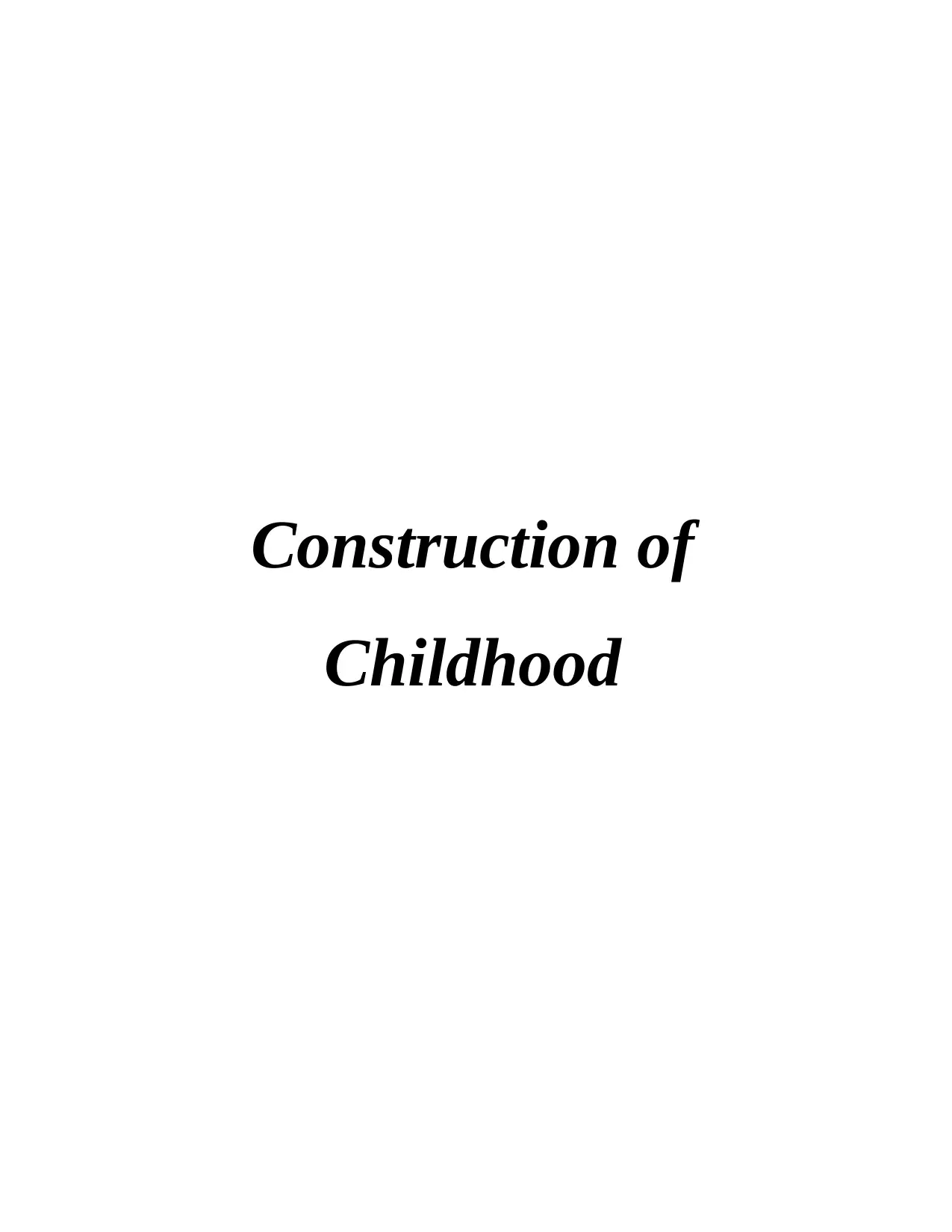
Construction of
Childhood
Childhood
Paraphrase This Document
Need a fresh take? Get an instant paraphrase of this document with our AI Paraphraser
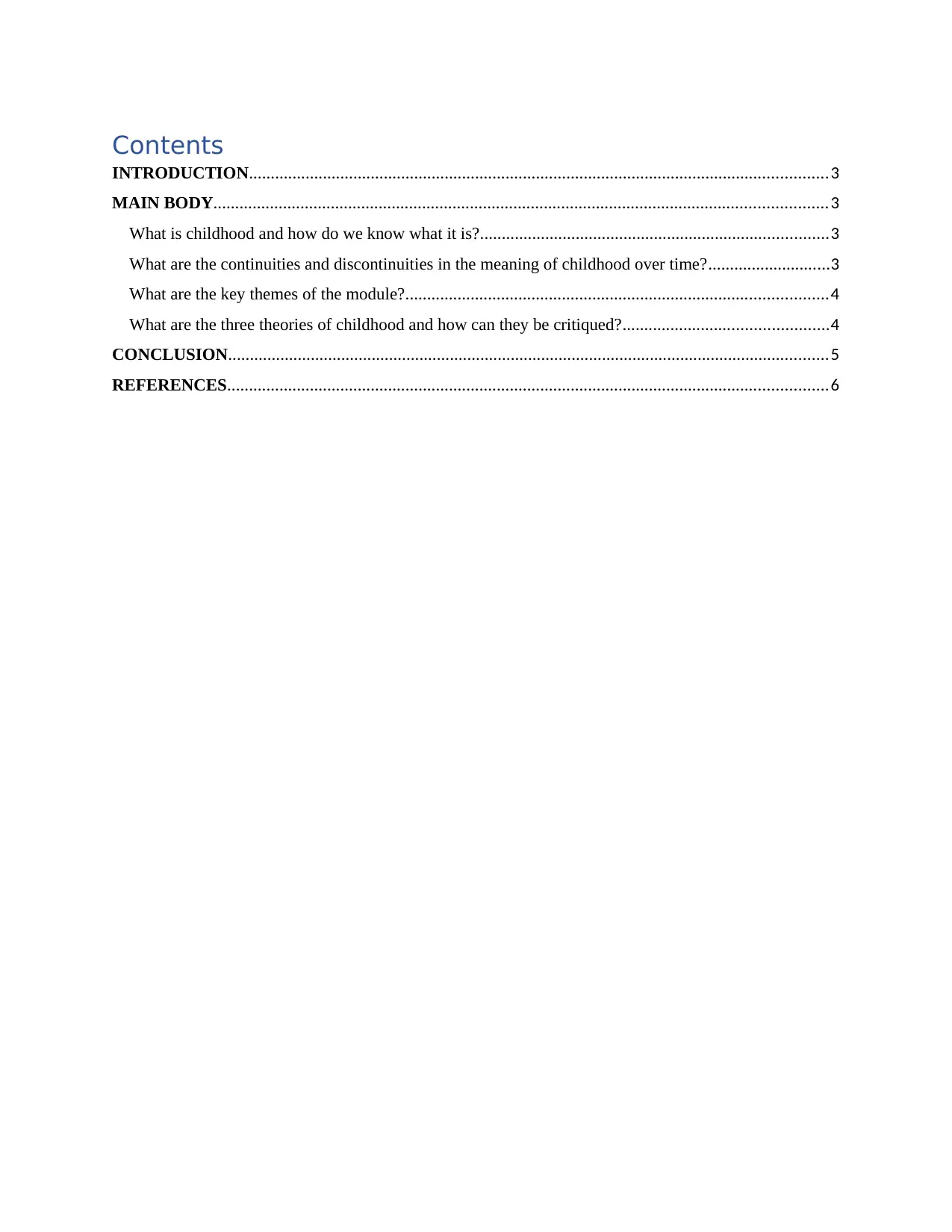
Contents
INTRODUCTION.....................................................................................................................................3
MAIN BODY.............................................................................................................................................3
What is childhood and how do we know what it is?................................................................................3
What are the continuities and discontinuities in the meaning of childhood over time?............................3
What are the key themes of the module?.................................................................................................4
What are the three theories of childhood and how can they be critiqued?...............................................4
CONCLUSION..........................................................................................................................................5
REFERENCES..........................................................................................................................................6
INTRODUCTION.....................................................................................................................................3
MAIN BODY.............................................................................................................................................3
What is childhood and how do we know what it is?................................................................................3
What are the continuities and discontinuities in the meaning of childhood over time?............................3
What are the key themes of the module?.................................................................................................4
What are the three theories of childhood and how can they be critiqued?...............................................4
CONCLUSION..........................................................................................................................................5
REFERENCES..........................................................................................................................................6
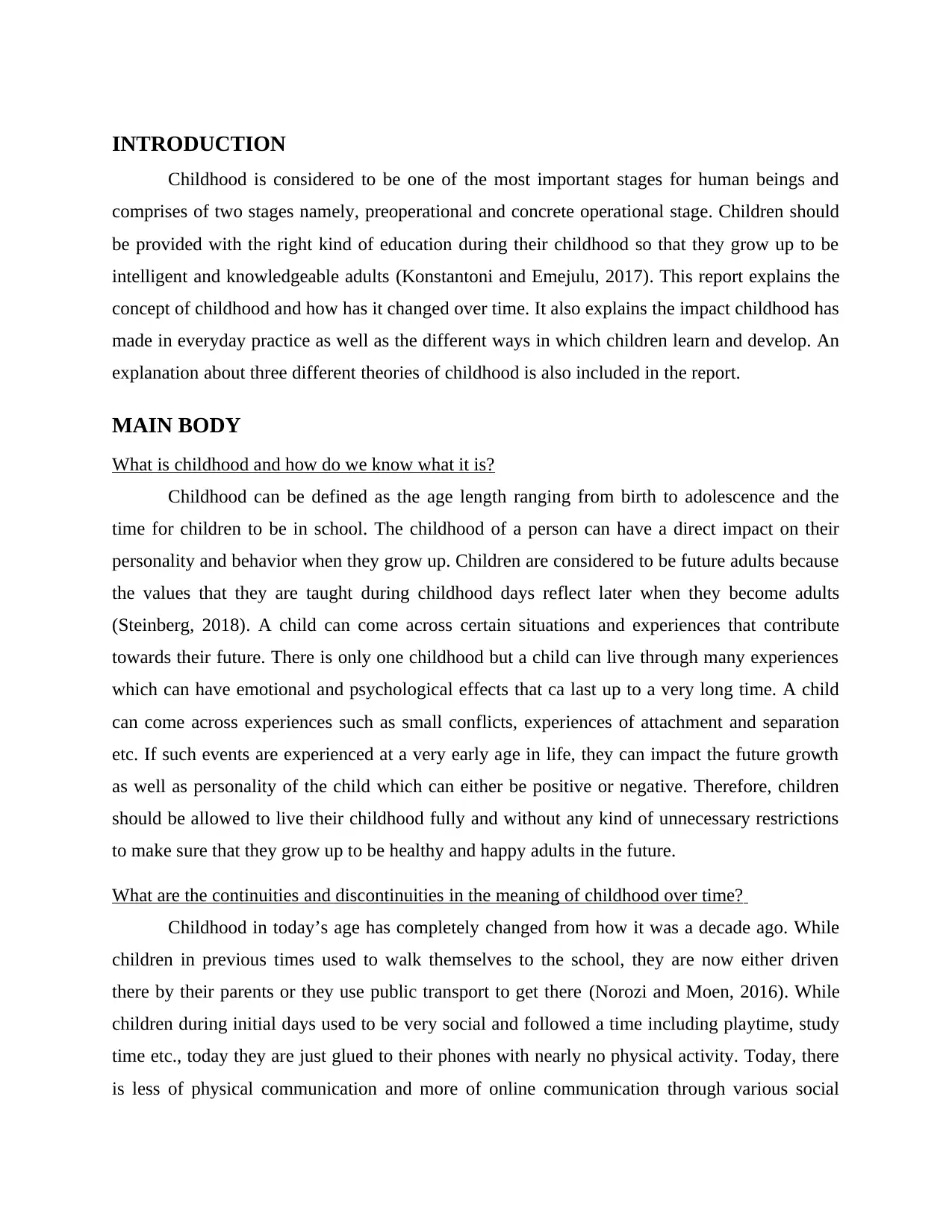
INTRODUCTION
Childhood is considered to be one of the most important stages for human beings and
comprises of two stages namely, preoperational and concrete operational stage. Children should
be provided with the right kind of education during their childhood so that they grow up to be
intelligent and knowledgeable adults (Konstantoni and Emejulu, 2017). This report explains the
concept of childhood and how has it changed over time. It also explains the impact childhood has
made in everyday practice as well as the different ways in which children learn and develop. An
explanation about three different theories of childhood is also included in the report.
MAIN BODY
What is childhood and how do we know what it is?
Childhood can be defined as the age length ranging from birth to adolescence and the
time for children to be in school. The childhood of a person can have a direct impact on their
personality and behavior when they grow up. Children are considered to be future adults because
the values that they are taught during childhood days reflect later when they become adults
(Steinberg, 2018). A child can come across certain situations and experiences that contribute
towards their future. There is only one childhood but a child can live through many experiences
which can have emotional and psychological effects that ca last up to a very long time. A child
can come across experiences such as small conflicts, experiences of attachment and separation
etc. If such events are experienced at a very early age in life, they can impact the future growth
as well as personality of the child which can either be positive or negative. Therefore, children
should be allowed to live their childhood fully and without any kind of unnecessary restrictions
to make sure that they grow up to be healthy and happy adults in the future.
What are the continuities and discontinuities in the meaning of childhood over time?
Childhood in today’s age has completely changed from how it was a decade ago. While
children in previous times used to walk themselves to the school, they are now either driven
there by their parents or they use public transport to get there (Norozi and Moen, 2016). While
children during initial days used to be very social and followed a time including playtime, study
time etc., today they are just glued to their phones with nearly no physical activity. Today, there
is less of physical communication and more of online communication through various social
Childhood is considered to be one of the most important stages for human beings and
comprises of two stages namely, preoperational and concrete operational stage. Children should
be provided with the right kind of education during their childhood so that they grow up to be
intelligent and knowledgeable adults (Konstantoni and Emejulu, 2017). This report explains the
concept of childhood and how has it changed over time. It also explains the impact childhood has
made in everyday practice as well as the different ways in which children learn and develop. An
explanation about three different theories of childhood is also included in the report.
MAIN BODY
What is childhood and how do we know what it is?
Childhood can be defined as the age length ranging from birth to adolescence and the
time for children to be in school. The childhood of a person can have a direct impact on their
personality and behavior when they grow up. Children are considered to be future adults because
the values that they are taught during childhood days reflect later when they become adults
(Steinberg, 2018). A child can come across certain situations and experiences that contribute
towards their future. There is only one childhood but a child can live through many experiences
which can have emotional and psychological effects that ca last up to a very long time. A child
can come across experiences such as small conflicts, experiences of attachment and separation
etc. If such events are experienced at a very early age in life, they can impact the future growth
as well as personality of the child which can either be positive or negative. Therefore, children
should be allowed to live their childhood fully and without any kind of unnecessary restrictions
to make sure that they grow up to be healthy and happy adults in the future.
What are the continuities and discontinuities in the meaning of childhood over time?
Childhood in today’s age has completely changed from how it was a decade ago. While
children in previous times used to walk themselves to the school, they are now either driven
there by their parents or they use public transport to get there (Norozi and Moen, 2016). While
children during initial days used to be very social and followed a time including playtime, study
time etc., today they are just glued to their phones with nearly no physical activity. Today, there
is less of physical communication and more of online communication through various social
⊘ This is a preview!⊘
Do you want full access?
Subscribe today to unlock all pages.

Trusted by 1+ million students worldwide
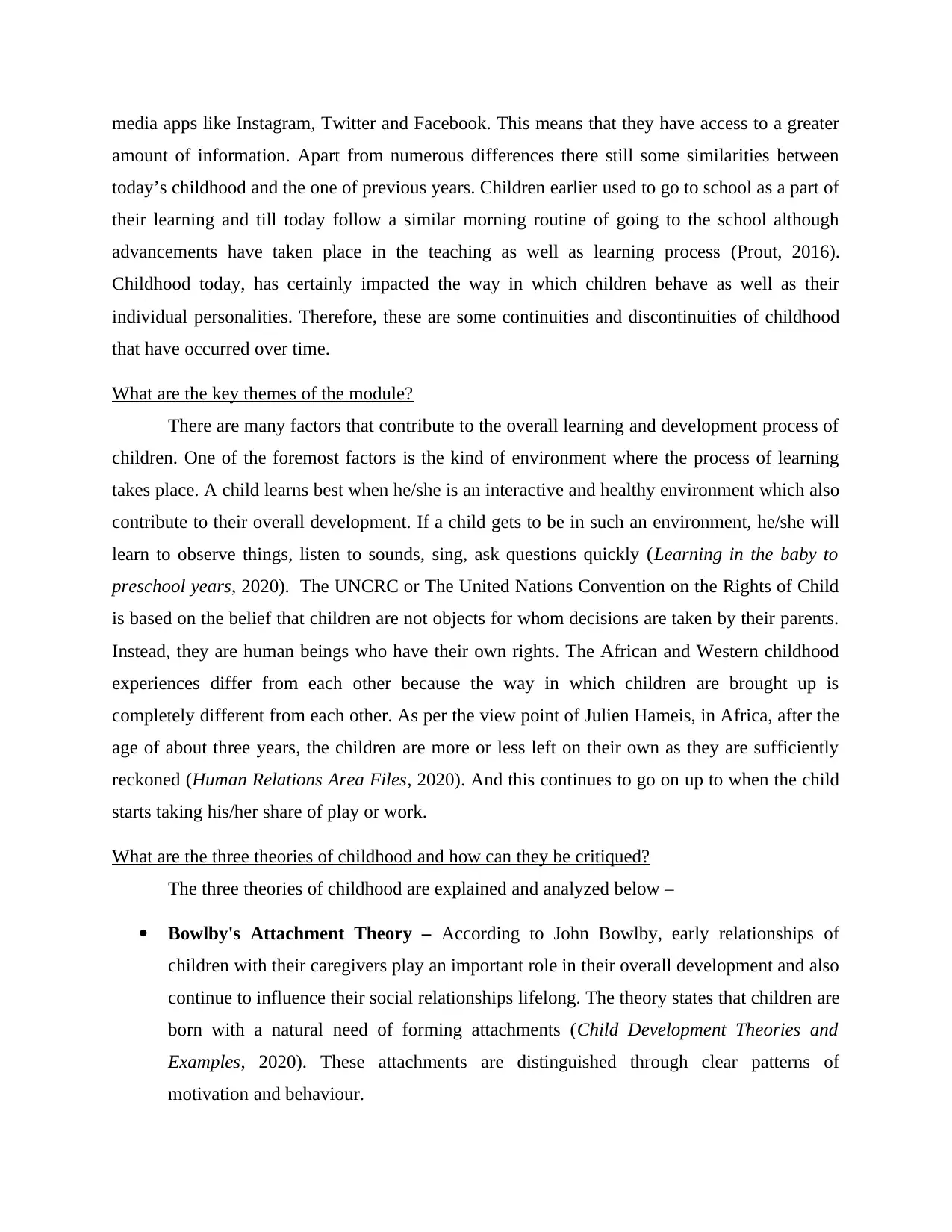
media apps like Instagram, Twitter and Facebook. This means that they have access to a greater
amount of information. Apart from numerous differences there still some similarities between
today’s childhood and the one of previous years. Children earlier used to go to school as a part of
their learning and till today follow a similar morning routine of going to the school although
advancements have taken place in the teaching as well as learning process (Prout, 2016).
Childhood today, has certainly impacted the way in which children behave as well as their
individual personalities. Therefore, these are some continuities and discontinuities of childhood
that have occurred over time.
What are the key themes of the module?
There are many factors that contribute to the overall learning and development process of
children. One of the foremost factors is the kind of environment where the process of learning
takes place. A child learns best when he/she is an interactive and healthy environment which also
contribute to their overall development. If a child gets to be in such an environment, he/she will
learn to observe things, listen to sounds, sing, ask questions quickly (Learning in the baby to
preschool years, 2020). The UNCRC or The United Nations Convention on the Rights of Child
is based on the belief that children are not objects for whom decisions are taken by their parents.
Instead, they are human beings who have their own rights. The African and Western childhood
experiences differ from each other because the way in which children are brought up is
completely different from each other. As per the view point of Julien Hameis, in Africa, after the
age of about three years, the children are more or less left on their own as they are sufficiently
reckoned (Human Relations Area Files, 2020). And this continues to go on up to when the child
starts taking his/her share of play or work.
What are the three theories of childhood and how can they be critiqued?
The three theories of childhood are explained and analyzed below –
Bowlby's Attachment Theory – According to John Bowlby, early relationships of
children with their caregivers play an important role in their overall development and also
continue to influence their social relationships lifelong. The theory states that children are
born with a natural need of forming attachments (Child Development Theories and
Examples, 2020). These attachments are distinguished through clear patterns of
motivation and behaviour.
amount of information. Apart from numerous differences there still some similarities between
today’s childhood and the one of previous years. Children earlier used to go to school as a part of
their learning and till today follow a similar morning routine of going to the school although
advancements have taken place in the teaching as well as learning process (Prout, 2016).
Childhood today, has certainly impacted the way in which children behave as well as their
individual personalities. Therefore, these are some continuities and discontinuities of childhood
that have occurred over time.
What are the key themes of the module?
There are many factors that contribute to the overall learning and development process of
children. One of the foremost factors is the kind of environment where the process of learning
takes place. A child learns best when he/she is an interactive and healthy environment which also
contribute to their overall development. If a child gets to be in such an environment, he/she will
learn to observe things, listen to sounds, sing, ask questions quickly (Learning in the baby to
preschool years, 2020). The UNCRC or The United Nations Convention on the Rights of Child
is based on the belief that children are not objects for whom decisions are taken by their parents.
Instead, they are human beings who have their own rights. The African and Western childhood
experiences differ from each other because the way in which children are brought up is
completely different from each other. As per the view point of Julien Hameis, in Africa, after the
age of about three years, the children are more or less left on their own as they are sufficiently
reckoned (Human Relations Area Files, 2020). And this continues to go on up to when the child
starts taking his/her share of play or work.
What are the three theories of childhood and how can they be critiqued?
The three theories of childhood are explained and analyzed below –
Bowlby's Attachment Theory – According to John Bowlby, early relationships of
children with their caregivers play an important role in their overall development and also
continue to influence their social relationships lifelong. The theory states that children are
born with a natural need of forming attachments (Child Development Theories and
Examples, 2020). These attachments are distinguished through clear patterns of
motivation and behaviour.
Paraphrase This Document
Need a fresh take? Get an instant paraphrase of this document with our AI Paraphraser
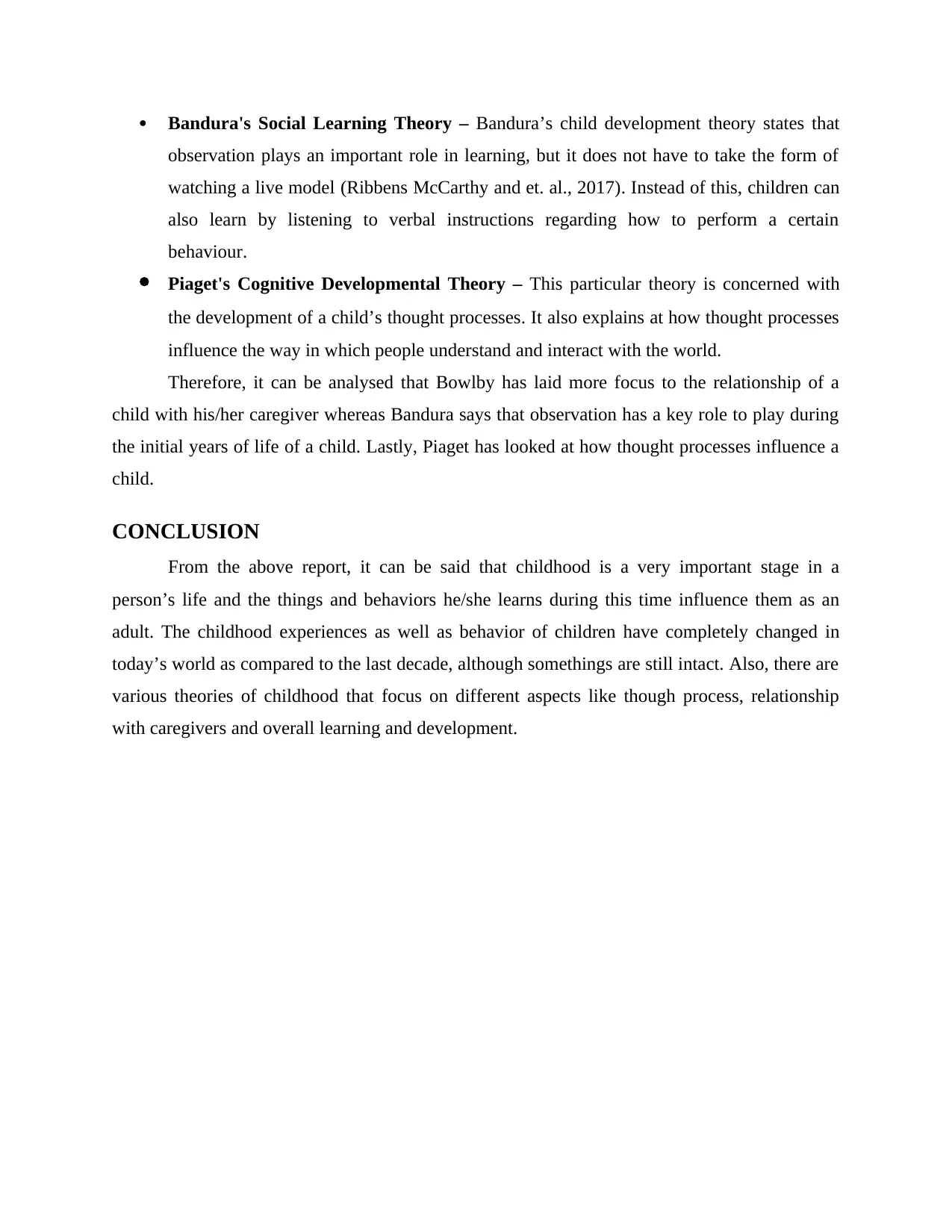
Bandura's Social Learning Theory – Bandura’s child development theory states that
observation plays an important role in learning, but it does not have to take the form of
watching a live model (Ribbens McCarthy and et. al., 2017). Instead of this, children can
also learn by listening to verbal instructions regarding how to perform a certain
behaviour.
Piaget's Cognitive Developmental Theory – This particular theory is concerned with
the development of a child’s thought processes. It also explains at how thought processes
influence the way in which people understand and interact with the world.
Therefore, it can be analysed that Bowlby has laid more focus to the relationship of a
child with his/her caregiver whereas Bandura says that observation has a key role to play during
the initial years of life of a child. Lastly, Piaget has looked at how thought processes influence a
child.
CONCLUSION
From the above report, it can be said that childhood is a very important stage in a
person’s life and the things and behaviors he/she learns during this time influence them as an
adult. The childhood experiences as well as behavior of children have completely changed in
today’s world as compared to the last decade, although somethings are still intact. Also, there are
various theories of childhood that focus on different aspects like though process, relationship
with caregivers and overall learning and development.
observation plays an important role in learning, but it does not have to take the form of
watching a live model (Ribbens McCarthy and et. al., 2017). Instead of this, children can
also learn by listening to verbal instructions regarding how to perform a certain
behaviour.
Piaget's Cognitive Developmental Theory – This particular theory is concerned with
the development of a child’s thought processes. It also explains at how thought processes
influence the way in which people understand and interact with the world.
Therefore, it can be analysed that Bowlby has laid more focus to the relationship of a
child with his/her caregiver whereas Bandura says that observation has a key role to play during
the initial years of life of a child. Lastly, Piaget has looked at how thought processes influence a
child.
CONCLUSION
From the above report, it can be said that childhood is a very important stage in a
person’s life and the things and behaviors he/she learns during this time influence them as an
adult. The childhood experiences as well as behavior of children have completely changed in
today’s world as compared to the last decade, although somethings are still intact. Also, there are
various theories of childhood that focus on different aspects like though process, relationship
with caregivers and overall learning and development.
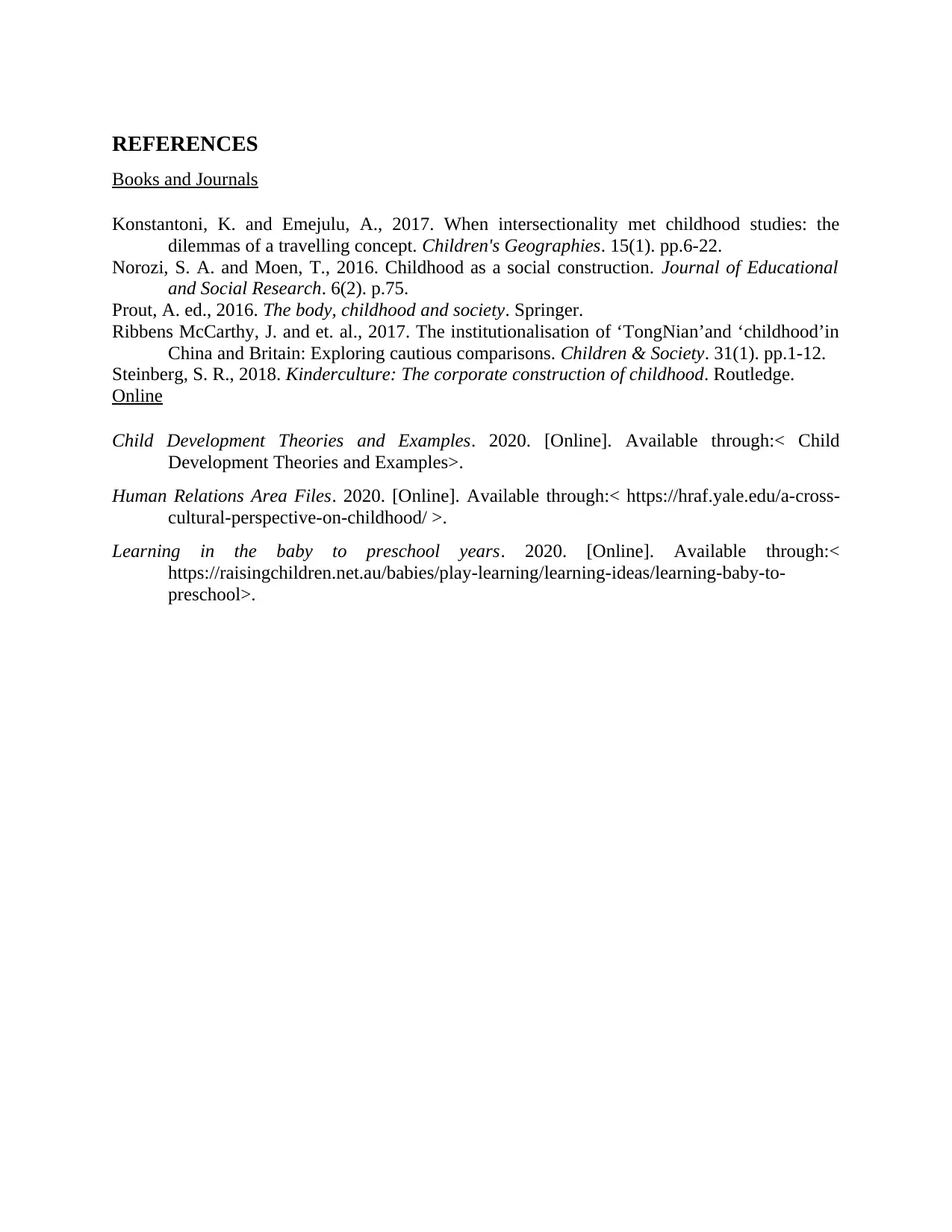
REFERENCES
Books and Journals
Konstantoni, K. and Emejulu, A., 2017. When intersectionality met childhood studies: the
dilemmas of a travelling concept. Children's Geographies. 15(1). pp.6-22.
Norozi, S. A. and Moen, T., 2016. Childhood as a social construction. Journal of Educational
and Social Research. 6(2). p.75.
Prout, A. ed., 2016. The body, childhood and society. Springer.
Ribbens McCarthy, J. and et. al., 2017. The institutionalisation of ‘TongNian’and ‘childhood’in
China and Britain: Exploring cautious comparisons. Children & Society. 31(1). pp.1-12.
Steinberg, S. R., 2018. Kinderculture: The corporate construction of childhood. Routledge.
Online
Child Development Theories and Examples. 2020. [Online]. Available through:< Child
Development Theories and Examples>.
Human Relations Area Files. 2020. [Online]. Available through:< https://hraf.yale.edu/a-cross-
cultural-perspective-on-childhood/ >.
Learning in the baby to preschool years. 2020. [Online]. Available through:<
https://raisingchildren.net.au/babies/play-learning/learning-ideas/learning-baby-to-
preschool>.
Books and Journals
Konstantoni, K. and Emejulu, A., 2017. When intersectionality met childhood studies: the
dilemmas of a travelling concept. Children's Geographies. 15(1). pp.6-22.
Norozi, S. A. and Moen, T., 2016. Childhood as a social construction. Journal of Educational
and Social Research. 6(2). p.75.
Prout, A. ed., 2016. The body, childhood and society. Springer.
Ribbens McCarthy, J. and et. al., 2017. The institutionalisation of ‘TongNian’and ‘childhood’in
China and Britain: Exploring cautious comparisons. Children & Society. 31(1). pp.1-12.
Steinberg, S. R., 2018. Kinderculture: The corporate construction of childhood. Routledge.
Online
Child Development Theories and Examples. 2020. [Online]. Available through:< Child
Development Theories and Examples>.
Human Relations Area Files. 2020. [Online]. Available through:< https://hraf.yale.edu/a-cross-
cultural-perspective-on-childhood/ >.
Learning in the baby to preschool years. 2020. [Online]. Available through:<
https://raisingchildren.net.au/babies/play-learning/learning-ideas/learning-baby-to-
preschool>.
⊘ This is a preview!⊘
Do you want full access?
Subscribe today to unlock all pages.

Trusted by 1+ million students worldwide
1 out of 6
Related Documents
Your All-in-One AI-Powered Toolkit for Academic Success.
+13062052269
info@desklib.com
Available 24*7 on WhatsApp / Email
![[object Object]](/_next/static/media/star-bottom.7253800d.svg)
Unlock your academic potential
Copyright © 2020–2025 A2Z Services. All Rights Reserved. Developed and managed by ZUCOL.




